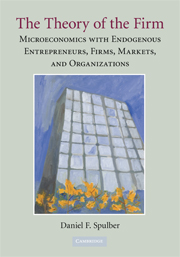 The Theory of the Firm
The Theory of the Firm Book contents
- Frontmatter
- Contents
- Preface and Acknowledgments
- Introduction
- PART I THE THEORY OF THE FIRM
- PART II THE ENTREPRENEUR IN EQUILIBRIUM
- PART III HUMAN CAPITAL, FINANCIAL CAPITAL, AND THE ORGANIZATION OF THE FIRM
- PART IV INTERMEDIATION BY THE FIRM
- PART V MARKET MAKING BY THE FIRM
- 12 Conclusion
- References
- Author Index
- Subject Index
- References
References
Published online by Cambridge University Press: 05 June 2012
- Frontmatter
- Contents
- Preface and Acknowledgments
- Introduction
- PART I THE THEORY OF THE FIRM
- PART II THE ENTREPRENEUR IN EQUILIBRIUM
- PART III HUMAN CAPITAL, FINANCIAL CAPITAL, AND THE ORGANIZATION OF THE FIRM
- PART IV INTERMEDIATION BY THE FIRM
- PART V MARKET MAKING BY THE FIRM
- 12 Conclusion
- References
- Author Index
- Subject Index
- References
- Type
- Chapter
- Information
- The Theory of the FirmMicroeconomics with Endogenous Entrepreneurs, Firms, Markets, and Organizations, pp. 465 - 502Publisher: Cambridge University PressPrint publication year: 2009
References
- 2
- Cited by


